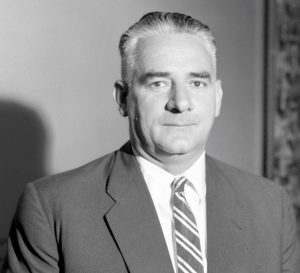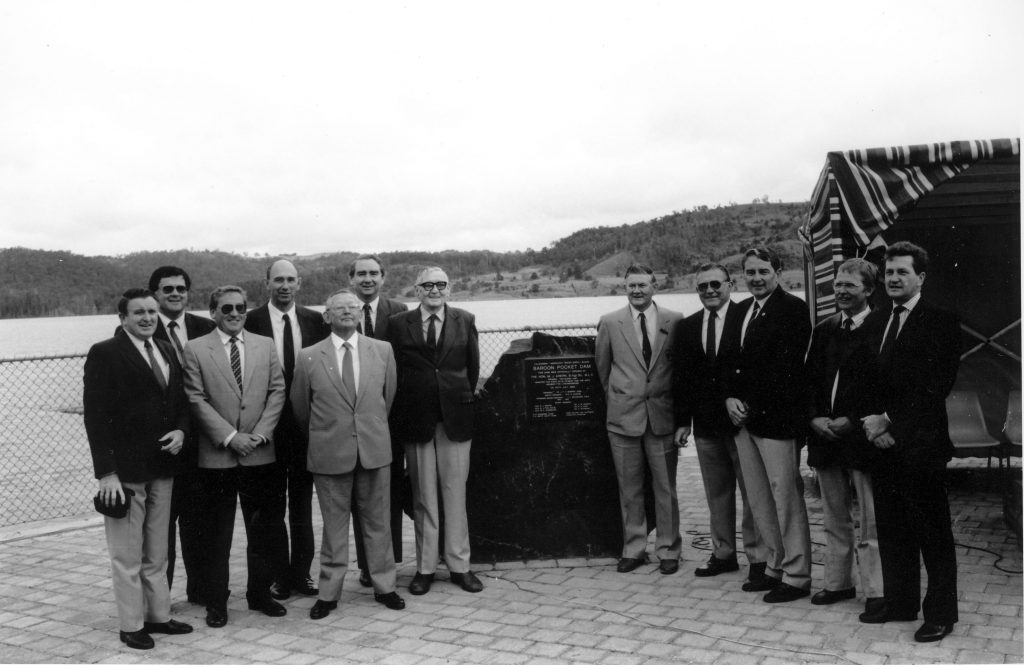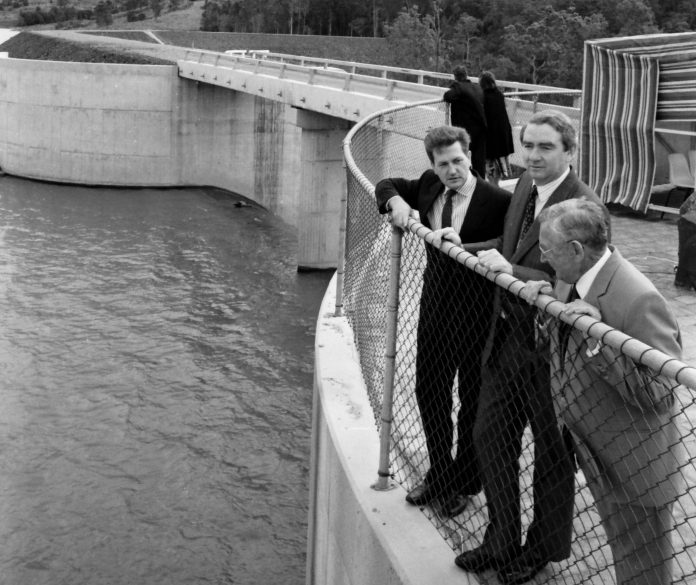City fathers first began to pay attention to water as a community resource in the 1950s. Until then, it was every man for himself, with individual householders relying on rainwater tanks.
A dam site on Obi Obi Creek at Baroon Pocket was first identified in 1946 as a worthy water supply that could serve both Maroochy and Landsborough Shires, but the proposal became lost in the rivalry between each council’s consulting engineers.
Landsborough Shire’s John Wilson had been investigating Baroon Pocket since the early 1940s and recommended a dam similar to the one that was eventually constructed, but it was consistently opposed by Maroochy Shire’s Jack Mulholland.
In the early 1950s, Mulholland persuaded Maroochy Shire chairman Dave Low (pictured below), who was also the local State Member of Parliament, that Maroochy Shire would be better off establishing its own water supply on the Maroochy River rather than combining with Landsborough for a joint scheme on Obi Obi Creek.

Investigations found the whole scheme to be economically unviable and each shire went its own way.
Maroochy Shire went on to implement the region’s first reticulated town water supply scheme in 1961.
Wappa Dam was built on the upper reaches of the Maroochy River south of Yandina, with a capacity of 4550 megalitres and the smaller diversion weir Poona Dam, opened at Image Flat.
A system of trunk mains took the water to the townships of Nambour, Alexandra Headland, Maroochydore, Mooloolaba, Buderim, Bli Bli, Coolum, Eumundi, Palmwoods, Woombye and Yandina.
Caloundra’s major water supply scheme started in 1964 after a weir was built on the Mooloolah River and connected to a nearby earth ring tank, a trunk main to Caloundra and reticulation in the town area. It served a population of 3000.
Within a decade, water supply was again under pressure.
Maroochy raised the level of Wappa Dam in 1971 and Landsborough built Ewan Maddock Dam on Adlington Creek in 1975. Construction started on Cooloolabin Dam in 1978.
It was reported in August 1978 that: “Although further development in the region and accompanying increases in population will undoubtedly occur in the future, considerable provision for further growth in demand has been designed into the present water supply systems which should ensure adequate supplies are available in the area up to the turn of the century.”
But by 1980, both Maroochy and Landsborough shires had realised they would be running out of water within the decade and further investigations were commissioned. A wide range of alternatives was examined, including further storages on both the Mooloolah and Maroochy River systems and new storages and diversion schemes from the Mary River, including Obi Obi Creek.
Help keep more great Coast memories alive by subscribing to our free daily news feed. Go to Subscribe at the top of this story and add your name and email. It’s that simple.
A report by the Queensland Water Resources Commission in April 1981, concluded that the optimum source for both Landsborough and Maroochy was a joint scheme based on a dam on Obi Obi Creek at Baroon Pocket.
Location of a new water supply was among the main issues when a new Maroochy Shire Council was elected in 1982 but the big question was, build at Baroon Pocket or enlarge Wappa. They favoured raising the Wappa wall.
As it turned out, the population exploded and three years later, in April 1985, a month after a new council was elected, Maroochy and Landsborough shires voted to proceed with construction of the Baroon Pocket Dam, on the same site first proposed some 40 years earlier, at a cost of $50 million.

The dam officially opened on July 28, 1989, and, a success story from the start, has been the saviour of the central Sunshine Coast.
The cost came in at less than $40 million, or $10 million under original estimate, and was full to overflowing within five months.
The Cooloolabin Dam, high in the foothills of the Blackall Range within the Maroochy Shire and with about one-quarter of the capacity of Baroon Pocket, was completed in 1979, and overflowed for the first time only a week earlier than Baroon Pocket.
This flashback is brought to you by veteran Sunshine Coast journalist and history writer Dot Whittington, also the editor of Your Time Magazine.





